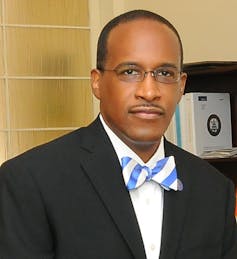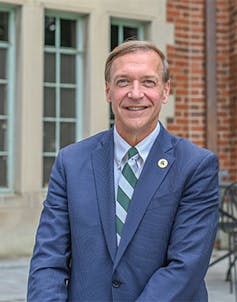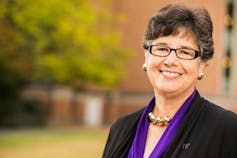Presidents' panel: How COVID-19 will change higher education

COVID-19 has altered nearly every aspect of higher education. Gerald Herbert/AP
Courtesy of Walter M. Kimbrough, Dillard University; Ana Mari Cauce, University of Washington, and Samuel L. Stanley, Michigan State University
Editor’s note: From time to time, we ask the leaders of our country’s colleges and universities to address some of the most pressing issues in higher education. Here, the presidents of three universities answer six critical questions about the future of higher education as its being reshaped by COVID-19.
Beyond just moving online, how is COVID-19 forcing colleges to change?

Walter M. Kimbrough, president of Dillard University. 'from www.dillard.edu'
Walter M. Kimbrough, president of Dillard University: The disruption is causing us to rethink much of how we operate. Do we offer the right majors? How much time do students need to complete a class or a degree? How can we use technology more effectively? I think all of these will impact conversations going forward, but I also think COVID-19 has reminded us that as humans, we need personal interaction. Simply doing everything virtually is not optimal.
Samuel L. Stanley, president of Michigan State University:
Michigan State has elevated our research and medical programs to recognize and better address health disparities related to COVID-19 and from other causes. For instance, we’ve partnered with a local county health department to provide COVID-19 testing to at-risk communities.

Samuel L. Stanley, president of Michigan State University. 'from www.president.msu.edu
We are also working with the Henry Ford Health System in Detroit to improve access, affordability and outcomes for Michigan’s most vulnerable populations. Additionally, we are helping to lead a statewide initiative with Detroit Medical Center to address health disparities among women of color throughout the state.
Meanwhile, we established an online resource for working, teaching, learning and researching. This summer, faculty and staff have been participating in professional development programs for online and hybrid learning to ensure the best experience possible for our students. And we are realizing the continued need for more frequent communication to keep our many audiences — students, faculty, staff, alumni, families and the community — informed through all the uncertainty.

Ana Mari Cauce, president of the University of Washington. 'from www.washington.edu'
Ana Mari Cauce, president of the University of Washington:
We have been reexamining an array of long-standing practices and assumptions – whether it be who has the equipment and access that students, faculty and staff need to receive or offer online instruction or becoming more flexible with our version of “pass or fail” grading practices.
But our June 13 graduation ceremony is freshly on my mind. The move to a fully online ceremony was such a difficult and disappointing decision to have to make, as graduation day is truly the most cherished of traditions for students and their families, and for our entire campus community. Yet our Office of Ceremonies created what I believe was a wonderful, touching and meaningful virtual experience for our graduates. We, of course, hope students will still return to campus next year for a second in-person ceremony.
How do you expect the characteristics of the next few admitted classes to change in response to the virus?
Kimbrough: I expect new students to really want to be engaged even more after having the experience of being distanced for a while. My daughter is about to enter high school so she didn’t get to experience the joy of formally graduating from middle school. She wants to be with friends and I think values relationships even more. Likewise, this year’s college freshmen didn’t get the traditional high school graduation experience, so they are very eager for a coming of age experience that college can provide.
Stanley: For many universities, maintaining enrollment has become a significant priority. That will continue over the next few entering classes. This is particularly true for international student enrollment, which is so important to the goal of U.S. colleges and universities to be culturally diverse institutions with worldwide influence.
Michigan State expects to see more in-state students, given parental and student concerns about traveling away from home, and they will have an educational experience that is much more reliant on online and remote learning. Faculty members are working to put about half of their classes online, shift about a quarter of their classes to a hybrid model of instruction and move the remaining in-person classes into larger rooms to allow for 6 feet of physical distancing.
Yet we will continue to provide in-person teaching where it clearly matters — laboratory work, creative arts, small seminars. It will also be important to seek ways to add more social and experiential activities that are consistent with remote or social distancing measures.
Finally, we’ll ask everyone to take greater personal responsibility to mitigate exposure and spread by wearing face coverings, limiting the size of in-person classes and regulating large gatherings. This will be a challenge, but we took similar actions to ban tobacco use on campus, and it required student, faculty and staff buy-in to make that possible. It is incredibly important that students unite in embracing the protective actions necessary to create a safer environment on campus.
Cauce: Resilient just barely begins to describe the incoming classes I expect to see. For everything they will have experienced – incomplete or online-based school years, detachment from friends and loved ones and perhaps direct impacts from this virus on their families – to have persevered through this phase in their lives and stayed dedicated to their education is nothing short of remarkable. I expect they will have a deep appreciation for the in-person campus experience. My biggest concern is making sure that the disproportionate financial impact of COVID-19 on low-income families, first-generation and underrepresented students does not set us back at a time when we were making real progress in ensuring that more of them have access to colleges and universities offering high-quality education.
Can you do college without sports?
Kimbrough: Sure you can, but we have heard so many in our nation lament not having sports because it is a big part of being American. I think the ESPN docu-series on Michael Jordan, “The Last Dance,” was super successful in part because we had no sports, so watching the story of Jordan’s last year felt like sports. For five weeks it seemed like we forgot about COVID-19 every Sunday night to hear all of the stories surrounding Jordan and that last season.
Stanley: While sports aren’t a true necessity, the college experience to many people includes earning a valuable degree and watching or participating in intercollegiate athletics. Sports unify a campus and create a strong identity. And once students graduate, sports can be an important means of keeping connected to their college or university. We often say, “You are students for a few years but alumni for a lifetime.” I also know that sports play an important role for student-athletes as many earn their degrees and go on to success in a completely different sphere, thanks in large part to an athletic scholarship or the skills they gain as a member of a team.
Cauce: We could, but we don’t want to. My heart aches for those student-athletes whose senior years were cut short or missed completely in the spring. With the fall coming, I know football is on the minds of many – and it is a huge source of pride, connection and community among our students, alumni and throughout the region. But every sport is filled with dedicated individuals who represent us so well that losing competitive sports would be a real loss to their experience and ours. I would add that the same loss would hold true if we are unable to resume our performing arts events and reopen our museums — these are places where students come together and that keep our alumni returning to campus.
Do you see any challenges of doing research with social distancing rules in effect?
Kimbrough: We are primarily a teaching institution but our faculty who engage in STEM research are continuing their work. Everyone in the world is studying the virus and reports are being produced now. But social science research should be very robust these days, because this is a new experience and we need to learn how this is impacting us. There needs to be lots of studies about kids in K-12 and if they lost learning, or studies about domestic violence during the pandemic, or how people dealt with their faith not going to houses of worship. There are lots of fascinating research opportunities.
Stanley: Scientists whose laboratories were paused stayed productive doing work such as analyzing data and a significant number of publications and grant proposals are going out our doors. Research has also carried on in the agricultural sciences and areas that received clearance to work on COVID-19 projects.
Research spaces have always followed rigorous health and safety protocols, so much of this isn’t new. Our labs are following detailed multistep programs as they reopen, from evaluating air and water systems to physical changes that accommodate new safety measures to defining occupation density, planning staggered shifts, stipulating face coverings and other measures. Nearly 300 of our labs have already turned in safety plans and 28 buildings were open as of July 1. Research related to human subjects is still restricted, though, and will likely be one of the last phases to resume because human contact is the primary source of infection.
Cauce: Absolutely. The adjustments we are making aren’t easy, but our faculty and students play a vital role in the world of discovery generally, and directly in the fight against COVID-19. Our Virology Lab was among the first to develop a viable test and we are – as are many talented scientists at other universities around the world – working toward treatments and a vaccine. Our experts in psychology, sociology, public policy, law and so many other areas are also increasing our understanding of the pandemic’s effects. Research has never been more critical, and we will rise to this challenge.
How will higher education make up for lost ground and lost revenue?
Kimbrough: I don’t think we lost too much ground in terms of the educational experience. I think people worked really hard to close out the semester and in many cases I think people created new opportunities for engagement. Congress helped a great deal with the CARES Act to minimize the lost revenue, but places with significant auxiliary operations like hosting conferences, campus and concert venues, including in the summer, have taken a big hit. I don’t know if that can be made up anytime soon.
Stanley: Public universities and colleges, in particular, will suffer from state appropriations cuts and other budget impacts. We will have to find innovative ways to maintain the faculty, staffs and facilities that have created the best research universities in the world. In addition, I’m genuinely concerned about our most vulnerable students, who, due to health concerns or family financial setbacks, may be unable to continue their pursuit of a college degree, perhaps forever. It will be important to maintain or broaden access to a college education – at a point when the nation needs it for many reasons, including to address inequity.
Cauce: The lost revenue is a deep concern. The cruel irony is that while our UW Medicine enterprise has been saving lives and answering the call against COVID-19, that very work has forced a projected $500 million in financial losses largely due to the shuttering of all non-urgent procedures. Auxiliary units such as Facilities, Housing & Food Services, Athletics and our Study Abroad programs are also facing significant losses. Federal and state stimulus support is helping, and we are hoping for further recognition of the vital work that universities like ours have done and will do during the recovery – however long it takes. But, as concerning as these losses are, we are just as concerned about the losses yet to come as state budgets contract. Higher education is often in the “discretionary” column in these budgets, but the fight against COVID-19 has demonstrated again that the work universities do is anything but discretionary.
Where’s the silver lining?
Kimbrough: I think this is an exciting time, one that we need to lean in to and find new and creative ways to operate. It will be a time to use technology to strengthen relationships, and to fully appreciate being in community with one another.
Stanley: As a physician with a background in infectious disease research, I hope society gains a renewed appreciation for science and medicine as we address this massive public health crisis. We are demonstrating the enduring value and return on investment from research universities such as Michigan State. We’re collaboratively bringing to bear a huge store of knowledge and the means to apply it to defeat the virus, while supporting our communities with vital skills and resources, and, by the way, training the next generation of scientists, doctors, educators and creators.
Cauce: It has revealed incredible strength, capability and creativity across our university and all of higher education, and it has forced us to be flexible in ways that don’t always come naturally to those of us who are planners. Yet, in a world characterized by climate change and increasing interconnectedness and migration, these attributes will be increasingly important in the future. Our students, faculty and staff have adjusted remarkably well in the face of this unprecedented challenge. I know it hasn’t been easy or everything we would have wanted, but the response has been extraordinary, and we will take everything we learned this spring and make the fall quarter experience even stronger.
![]()
Walter M. Kimbrough, President of Dillard University, Dillard University; Ana Mari Cauce, President, University of Washington, and Samuel L. Stanley, President, Michigan State University
This article is republished from The Conversation under a Creative Commons license. Read the original article.
[You need to understand the coronavirus pandemic, and we can help. Read The Conversation’s newsletter.]



